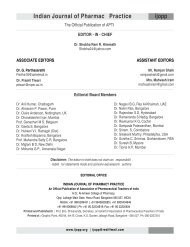Jul-Sep, 2012 - Indian Journal of Pharmacy Practice
Jul-Sep, 2012 - Indian Journal of Pharmacy Practice
Jul-Sep, 2012 - Indian Journal of Pharmacy Practice
Create successful ePaper yourself
Turn your PDF publications into a flip-book with our unique Google optimized e-Paper software.
Mohammed S.S - The Prevalence <strong>of</strong> Polypharmacy in South <strong>Indian</strong> Patients: A Pharmacoepidemiological Approach.c) Polypharmacy Vs Hospital stays: The association <strong>of</strong>polypharmacy and hospital stay was analyzed and the resultsare given in Table 3. In both minor and major polypharmacyhospital stay less than one week found. In majorpolypharmacy about 45.50% had one to two weeks <strong>of</strong> hospitalstay.Quantitative Estimation <strong>of</strong> Therapeutic Categories <strong>of</strong>Prescriptions: The collected prescriptions were classifiedaccording to the British National Formulary and the number<strong>of</strong> prescriptions in each category is given in Table 4. Out <strong>of</strong> thetotal prescriptions cardiovascular, infections andgastrointestinal system accounted for major cases.Thepercentage <strong>of</strong> therapeutic categories <strong>of</strong> all prescribed drugs inthe study population is graphically represented in Figure 2.d) Therapeutic class Vs Polypharmacy: The assessment <strong>of</strong>polypharmacy in each therapeutic class was carried out andthe prevalence <strong>of</strong> polypharmacy was estimated. The resultsare presented in Table 5. The results shows that majorpolypharmacy is more prevalent in cardiovascular systemdiseases (31.5%) followed by infectious diseases (23.67%).e) Therapeutic class Vs Age group: The patient prescribedwith cardiovascular drugs and gastrointestinal drugs weremore <strong>of</strong>ten involved in the polypharmacy among the elderlypopulation, while infectious and cardiovascular drugs wereprominent among young individuals exposed topolypharmacy. The table 6 represents the conception <strong>of</strong>therapeutic class <strong>of</strong> drug by different age group.f) Therapeutic class Vs Hospital stays: The duration <strong>of</strong>treatment varies with severity <strong>of</strong> disease. Our result shows theheterogeneous data with respect to duration <strong>of</strong> therapy andFig. 2: Percentage <strong>of</strong> therapeutic categories <strong>of</strong> allprescribed drugs.Table 4: Quantitative Estimation <strong>of</strong> Therapeutic Categories<strong>of</strong> PrescriptionsTherapeutic class Number <strong>of</strong> prescription PercentagecollectedCardiovascular System 267 26.62%Infections 223 22.23%Gastrointestinal System 178 17.75%Respiratory System 144 14.36%Central Nervous System 120 11.96%Endocrine System 23 2.29%Musculoskeletal System 21 2.09%Dermatology 11 1.10%Obstetrics and Gynecology 16 1.60%Table 3: Polypharmacy Vs Hospital stayNumber <strong>of</strong> drugs 1 week 1-2 week >2 week Total Percentage <strong>of</strong>total prescription2-4 258 (64.02%) 117(29.03%) 28(6.95%) 403 40.18%≥5 296 (49.33%) 273(45.50%) 31(5.17%) 600 59.82%Table 5: Therapeutic class Vs PolypharmacyTherapeutic class Minor Polypharmacy Percentage Major Polypharmacy Percentage(2-4 drugs) (%) (≥5) (%)Cardiovascular System 78 19.35 189 31.50Infections 81 20.10 142 23.67Gastrointestinal System 97 24.07 81 13.50Respiratory System 73 18.11 71 11.83Central Nervous System 44 10.92 76 12.67Endocrine System 11 2.73 12 2.00Musculoskeletal System 12 2.98 9 1.50Dermatology 7 1.74 4 0.67Obstetrics and Gynecology Nil Nil 16 2.67<strong>Indian</strong> <strong>Journal</strong> <strong>of</strong> <strong>Pharmacy</strong> <strong>Practice</strong> Volume 5 Issue 3 <strong>Jul</strong> - <strong>Sep</strong>, <strong>2012</strong> 42
















